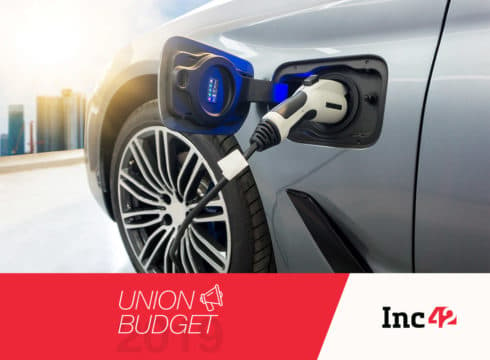Interim Finance Minister Piyush Goyal did not clarify on EV policy
No new initiatives to boost emobility was announced during the budget
The minister only reiterated the government goals for the development of EV sector
Inc42 Daily Brief
Stay Ahead With Daily News & Analysis on India’s Tech & Startup Economy
The government is aiming to make India greener and cleaner by 2030 by boosting the number of electric vehicles (EVs) in the country. While addressing the parliament during the interim Budget 2019-20, interim finance minister Piyush Goyal said that India will lead the world in transport in EVs and renewable energy, making India a pollution free nation.
However, the minister failed to provide details as to how does the central government plans on achieving this goal. During the budget session, no new initiatives or scheme to aid the growth in the segment were announced. The government’s token announcement means that the industry will continue to face uncertainty till the Parliament’s monsoon session when the budget may be revised.
Maxson Lewis, the managing director at Magenta Power, a solar products developer, said “Overall, the 2019 Budget has reiterated its goal of passenger vehicle electrification by 2030. What would have made a big positive impact however would have been a simple announcement of the removal of tolls for electric vehicles across India. This would have certainly given an emotive push for adoption of electric vehicles in India”.
There is no denying that the government has been taking several initiatives to boost emobility in the country. However, a lack of proper electric vehicle policy may prove to be a major setback for the industry. As South Korean car maker Kia reportedly pointed out in January, there is enough technology to roll out EVs in India but the lack of subsidies and incentives has made it hard to justify the investment in the country.
Recently, in line with the demand of the electric vehicle industry players, the government reduced customs duty on electric vehicle components which are imported in a knocked-down or semi knocked down state to 10%-15% from the existing 15% to 30%.
“We welcome the Department of Revenue’s relief on import duty of lithium-ion cells. Reduction of the customs duty on the knocked down kit of vehicles, however, goes against the spirit of “Make in India” since it might lead to flooding of the market with low-quality vehicles. We need a long term view to empower OEMs to build and “Make in India”, said Tarun Mehta, cofounder and CEO of Ather Energy.
Survey: Was the Union Budget 2019 up to the mark for the Indian startup ecosystem?EV Push: States Vs Union
Meanwhile, Indian state governments are pursuing bold policies and ambitious action plans while states such as Karnataka, Tamil Nadu and Delhi are implementing a clear policies to boost the growth in the segment.
Counted as one of most polluted states, India capital Delhi had announced ‘The Draft Delhi EV Policy 2018’ in November 2018 to make 25% of all vehicles to be EVs by 2023. It is also aimed at incentivising the purchase and use of electric two-wheelers and supporting the electrification of public/shared transport. Some other states such as Kerala, Telangana, Andhra Pradesh, Uttar Pradesh, Karnataka, and Gujarat are leading in the segment as they seek to implement their draft electric vehicle policy.
In January the Tamil Nadu government approved an investment of INR 7,000 Cr by passenger carmaker Hyundai Motors that will allow the company to make its electric car foray into the country by manufacturing units from its Sriperumbudur facility near Chennai.
Meanwhile in Karnataka, the Minister for Large and Medium Scale Industries – Commerce & Industries Department, KJ George, who inaugurated a Electric Vehicle Summit this week in Bengaluru, said that companies manufacturing EVs have come forward to invest INR 31K Cr in the state.
What Happened To FAME?
In a bid to boost the electric mobility in the country, the government had launched the FAME (Faster Adoption and Manufacture of (Hybrid and) Electric Vehicles) in 2015 to be implemented over two years between April 1, 2015 – March 31, 2017. Till date, the programme’s first phase has been extended four times and is scheduled to end by March this year.
Although under the FAME scheme, the government is hoping that by 2030 atleast 30% of the new car registrations in the country will be EVs. But with less than 12 years to go, combined with the government’s hesitancy to introduce big ticket reforms, this seems like a pipe dream for now.
Back in in December, 2018, the Narendra Modi-led government’s decision to not announce the second phase of the FAME scheme during the Global Mobility Summit came as a huge setback for the industry. As a result the uncertainties, car makers and infrastructure players are being cautiously optimistic. However to significantly increase the adoption of electric and hybrid vehicles, the industry and policy makers need to work in tandem.
Survey: Was the Union Budget 2019 up to the mark for the Indian startup ecosystem?{{#name}}{{name}}{{/name}}{{^name}}-{{/name}}
{{#description}}{{description}}...{{/description}}{{^description}}-{{/description}}
Note: We at Inc42 take our ethics very seriously. More information about it can be found here.


